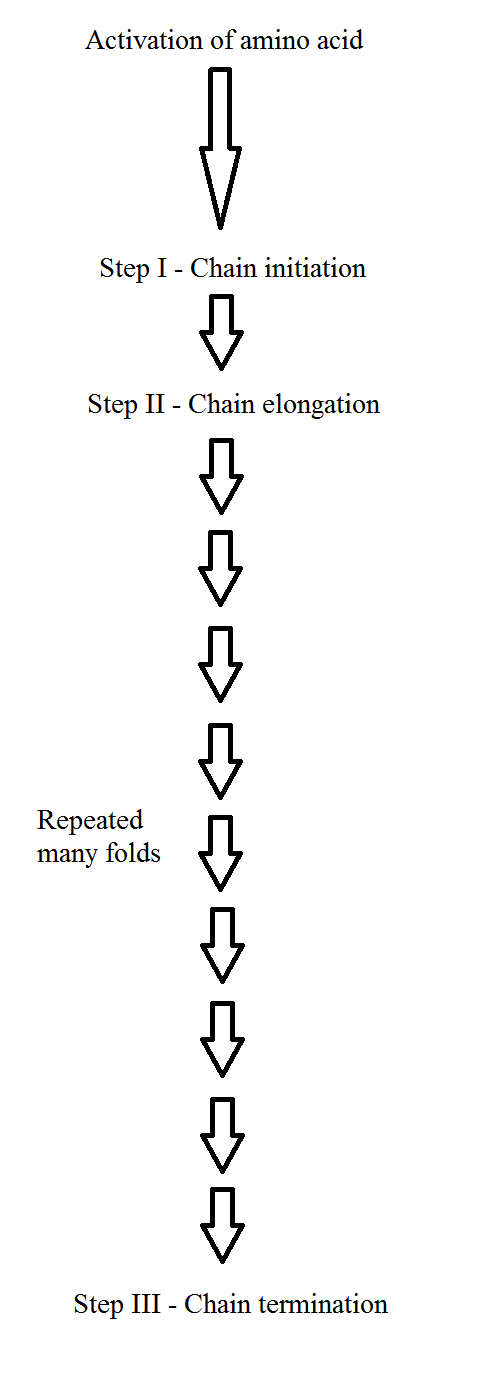
Concept explainers
RECALL Prepare a flow chart showing the stages of protein synthesis.
Interpretation:
A flow chart representing various stages of protein biosynthesis is to be prepared.
Concept introduction:
Proteins are large macromolecules, which consist of long sequences of amino acid residues. They are involved in a number of different biochemical processes in an organism.
They mostly differ in their structure and activity due to the arrangement of amino acid residues that is governed by their gene makeup.
Answer to Problem 1RE
Solution:

Explanation of Solution
Biosynthesis of protein is a complicated process that requires messenger and transfer RNA (mRNA and tRNA), ribosomes, and various protein factors. Ribosomes are the primary location for the biosynthesis of protein, to which the mRNA and tRNA are attached. The mRNA and tRNA are crucial for the correct arrangement of amino acids in the elongating chain.
The amino acid must be activated prior to being incorporated in the protein chain. The activation of amino acids requires tRNA and aminoacyl-tRNA synthetases (a group of specific enzymes). The amino acid residues get attached covalently to the tRNA forming aminoacyl-tRNA. The actual synthesis of polypeptide sequences takes place in three steps (chain initiation, chain elongation, and chain termination).
In the chain initiation step, the primary aminoacyl-tRNA gets attached to mRNA at a point that codes the initiation of polypeptide biosynthesis. The mRNA is attached with the ribosome, forming a complex. The subsequent aminoacyl-tRNA then makes a complex with the complex of ribosome and mRNA. The binding position for the subsequent aminoacyl-tRNA is adjacent to the primary aminoacyl-tRNA. Now, in the chain elongation step, formation of a peptide bond takes place between the amino acids. This process recurs until the polypeptide chain is accomplished. At last, in the chain termination step, the newly synthesized protein is released from the ribosomes.
The protein molecules are long chains of amino acids, the information for which is stored in the genetic code.
Want to see more full solutions like this?
Chapter 12 Solutions
Biochemistry
- Which features of the curves in Figure 30-2 indicates that the enzyme is not consumed in the overall reaction? ES is lower in energy that E + S and EP is lower in energy than E + P. What does this tell you about the stability of ES versus E + S and EP versus E + P.arrow_forwardLooking at the figure 30-5 what intermolecular forces are present between the substrate and the enzyme and the substrate and cofactors.arrow_forwardprovide short answers to the followings Urgent!arrow_forward
- Pyruvate is accepted into the TCA cycle by a “feeder” reaction using the pyruvatedehydrogenase complex, resulting in acetyl-CoA and CO2. Provide a full mechanismfor this reaction utilizing the TPP cofactor. Include the roles of all cofactors.arrow_forwardB- Vitamins are converted readily into important metabolic cofactors. Deficiency inany one of them has serious side effects. a. The disease beriberi results from a vitamin B 1 (Thiamine) deficiency and ischaracterized by cardiac and neurological symptoms. One key diagnostic forthis disease is an increased level of pyruvate and α-ketoglutarate in thebloodstream. How does this vitamin deficiency lead to increased serumlevels of these factors? b. What would you expect the effect on the TCA intermediates for a patientsuffering from vitamin B 5 deficiency? c. What would you expect the effect on the TCA intermediates for a patientsuffering from vitamin B 2 /B 3 deficiency?arrow_forwardDraw the Krebs Cycle and show the entry points for the amino acids Alanine,Glutamic Acid, Asparagine, and Valine into the Krebs Cycle - (Draw the Mechanism). How many rounds of Krebs will be required to waste all Carbons of Glutamic Acidas CO2?arrow_forward
- Sodium fluoroacetate (FCH 2CO2Na) is a very toxic molecule that is used as rodentpoison. It is converted enzymatically to fluoroacetyl-CoA and is utilized by citratesynthase to generate (2R,3S)-fluorocitrate. The release of this product is a potentinhibitor of the next enzyme in the TCA cycle. Show the mechanism for theproduction of fluorocitrate and explain how this molecule acts as a competitiveinhibitor. Predict the effect on the concentrations of TCA intermediates.arrow_forwardIndicate for the reactions below which type of enzyme and cofactor(s) (if any) wouldbe required to catalyze each reaction shown. 1) Fru-6-P + Ery-4-P <--> GAP + Sed-7-P2) Fru-6-P + Pi <--> Fru-1,6-BP + H2O3) GTP + ADP <--> GDP + ATP4) Sed-7-P + GAP <--> Rib-5-P + Xyl-5-P5) Oxaloacetate + GTP ---> PEP + GDP + CO 26) DHAP + Ery-4-P <--> Sed-1,7-BP + H 2O7) Pyruvate + ATP + HCO3- ---> Oxaloacetate + ADP + Piarrow_forwardTPP is also utilized in transketolase reactions in the PPP. Give a mechanism for theTPP-dependent reaction between Xylulose-5-phosphate and Ribose-5-Phosphate toyield Glyceraldehyde-3-phosphate and Sedoheptulose-7-Phosphate.arrow_forward
 BiochemistryBiochemistryISBN:9781305961135Author:Mary K. Campbell, Shawn O. Farrell, Owen M. McDougalPublisher:Cengage Learning
BiochemistryBiochemistryISBN:9781305961135Author:Mary K. Campbell, Shawn O. Farrell, Owen M. McDougalPublisher:Cengage Learning
